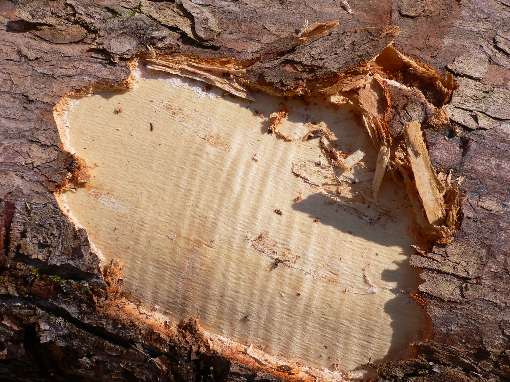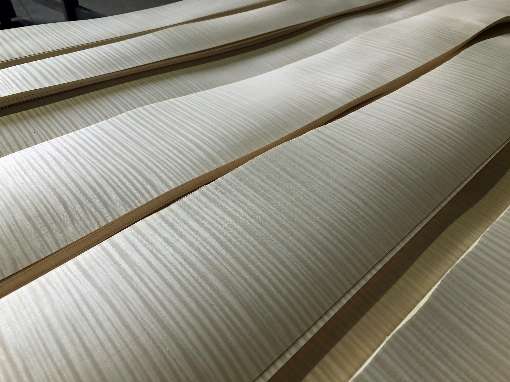19.06.2024
A real eye-catcher, and not just as a veneer:
Bonn/Karlsruhe. Veneer really brings out the beauty of wood. This is especially true for veneers made from wood from the timber frame. Surfaces finished with it - from designer furniture to high-quality musical instruments - deserve to be called "exceptional".
The wavy pattern of the wood fibers creates a highly decorative effect. It creates a special visual effect that gives the impression of light and dark stripes in the wood. This "framing" is rare and therefore particularly valuable. It usually only becomes visible after felling and does not always run across the entire trunk. "The sycamore maple is probably the tree species with the most recognizable framed wood structure. The proportion of framed specimens in natural sycamore populations is between one and five percent. This includes, for example, the Norway maple and field maple species native to Germany," explains Axel Groh, Chairman of the Initiative Furnier + Natur (IFN).
The reason for the formation is the subject of research The cause of the wavy, color-changing wood fibers that lead to the natural material's framing is still largely unknown. Various hypotheses have been discussed, with a genetic connection being suspected. Due to its rarity, efforts are being made in forestry and forestry research to propagate curly maple. "This can be done either via seed or vegetative propagation through grafting or tissue culture. The reliable identifiability of the clones with a genetic fingerprint ensures reliable propagation of the curly maple," says Groh.
The most important areas of application for curly maple and its veneer Traditionally, curly maple is used in musical instrument making, where it is used to make the backs and sides of many stringed instruments and to build stringed instruments such as fine concert grand pianos. This is where the common English name "fiddleback maple" comes from. Veneer is also making a name for itself in drum construction. Another important area for fiddleback maple and its veneer is exclusive furniture making. "Collector's items finished with it are highly sought after by interior designers. In addition, there are the most diverse areas of interior design, woodturning and carving work and even the finishing of motor vehicles, ships or airplanes can be achieved particularly impressively with Riegelholz veneer," concludes Axel Groh. IFN/DS
Initiative Veneer + Nature (IFN)
The Initiative Furnier + Natur (IFN) e.V. was founded in 1996 by the German veneer industry and its partners. Today it is supported by European companies from the veneer industry, the trade and the veneer processing industry as well as trade associations of the wood industry. The aim of the association is to promote veneer as a natural all-round material.
Further information about the company can be found at: www.sg-veneers.com oder
instagram
linkedin
facebook
youtube
Further information about the IFN at:
furnier.de/en
wood-veneer-stories.de
facebook
linkedin
instagram
Image 1: Axel Groh, Chairman of the Initiative Furnier + Natur (IFN). Photo: IFN
Image 2: A perfect veneer tree: the framed trunk of a European maple. Photo: © Schorn & Groh, Karlsruhe | www.sg-veneers.com
Image 3: This is how beautiful veneer made from curly maple is even before further processing. Photo: © Schorn & Groh, Karlsruhe | www.sg-veneers.com
June 19, 2024
Initiative Furnier + Natur e.V. - Bonner Talweg 84 - D-53113 Bonn - m +49 171 1783 444 www.furnier.de - www.veneer.eu - presse@furnier.de
A real eye-catcher, and not just as a veneer:
Framing wood is a natural work of art
Bonn/Karlsruhe. Veneer really brings out the beauty of wood. This is especially true for veneers made from wood from the timber frame. Surfaces finished with it - from designer furniture to high-quality musical instruments - deserve to be called "exceptional".
The wavy pattern of the wood fibers creates a highly decorative effect. It creates a special visual effect that gives the impression of light and dark stripes in the wood. This "framing" is rare and therefore particularly valuable. It usually only becomes visible after felling and does not always run across the entire trunk. "The sycamore maple is probably the tree species with the most recognizable framed wood structure. The proportion of framed specimens in natural sycamore populations is between one and five percent. This includes, for example, the Norway maple and field maple species native to Germany," explains Axel Groh, Chairman of the Initiative Furnier + Natur (IFN).
The reason for the formation is the subject of research The cause of the wavy, color-changing wood fibers that lead to the natural material's framing is still largely unknown. Various hypotheses have been discussed, with a genetic connection being suspected. Due to its rarity, efforts are being made in forestry and forestry research to propagate curly maple. "This can be done either via seed or vegetative propagation through grafting or tissue culture. The reliable identifiability of the clones with a genetic fingerprint ensures reliable propagation of the curly maple," says Groh.
The most important areas of application for curly maple and its veneer Traditionally, curly maple is used in musical instrument making, where it is used to make the backs and sides of many stringed instruments and to build stringed instruments such as fine concert grand pianos. This is where the common English name "fiddleback maple" comes from. Veneer is also making a name for itself in drum construction. Another important area for fiddleback maple and its veneer is exclusive furniture making. "Collector's items finished with it are highly sought after by interior designers. In addition, there are the most diverse areas of interior design, woodturning and carving work and even the finishing of motor vehicles, ships or airplanes can be achieved particularly impressively with Riegelholz veneer," concludes Axel Groh. IFN/DS
Initiative Veneer + Nature (IFN)
The Initiative Furnier + Natur (IFN) e.V. was founded in 1996 by the German veneer industry and its partners. Today it is supported by European companies from the veneer industry, the trade and the veneer processing industry as well as trade associations of the wood industry. The aim of the association is to promote veneer as a natural all-round material.
Further information about the company can be found at: www.sg-veneers.com oder
youtube
Further information about the IFN at:
furnier.de/en
wood-veneer-stories.de
Image 1: Axel Groh, Chairman of the Initiative Furnier + Natur (IFN). Photo: IFN
Image 2: A perfect veneer tree: the framed trunk of a European maple. Photo: © Schorn & Groh, Karlsruhe | www.sg-veneers.com
Image 3: This is how beautiful veneer made from curly maple is even before further processing. Photo: © Schorn & Groh, Karlsruhe | www.sg-veneers.com
June 19, 2024
Initiative Furnier + Natur e.V. - Bonner Talweg 84 - D-53113 Bonn - m +49 171 1783 444 www.furnier.de - www.veneer.eu - presse@furnier.de

Image 1: Axel Groh, Chairman of the Initiative Furnier + Natur (IFN). Photo: IFN

Image 2: A perfect veneer tree: the framed trunk of a European maple. Photo: © Schorn & Groh, Karlsruhe | www.sg-veneers.com

Image 3: This is how beautiful veneer made from curly maple is even before further processing. Photo: © Schorn & Groh, Karlsruhe | www.sg-veneers.com